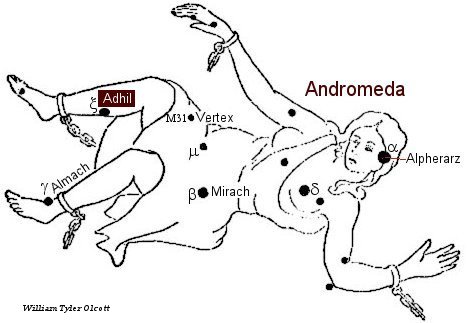I greatly enjoy looking at the night's sky although I can barely make out any of the constellations. As a new and regular series on Baring the Aegis, I want to share with you my study of the mythology behind various constellations. Today, I'm starting with Andromeda.
Androméda (Ἀνδρομέδα) is a princess, the daughter of Cepheus, king of Aethiopia, and his wife Cassiopeia. One faithful day, Cassiopeia boasted to an attentive court that her daughter was more beautiful than the Nereids. The father of the Nereids, the sea God Nereus, heard Cassiopeia's prideful boast and brought his grievance to Poseidon. Poseidon ruled in favor of Nereus and sent Cetus, a huge sea monster, to ravage the coasts of Aethiopia. Cepheus, desperate, visited the Oracle of Apollon to hear how he could solve the suffering of his people. The Oracle told his that Nereus would only be appeased when he sacrificed his daughter to Cetus.
Although Cepheus was reluctant, he knew it was the only way to keep his people safe, and so he took Androméda to a cliff overlooking the water and chained her to the rock. It is this image that was immortalized in the sky. Androméda was not sacrificed, though; Perseus, on his way back from defeating Médousa, came upon her and turned Cetus to stone with the Gorgon head. He married Androméda and took her off to his native island of Serifos. They had many children; sons Perses, Alcaeus, Heleus, Mestor, Sthenelus, and Electryon, as well as daughters, Autochthe and Gorgophone. After Androméda's death, Athena placed her among the constellations in the northern sky, near Perseus and Cassiopeia.
The Andromeda constellation is visible at latitudes between +90° and −40°. It is best visible at 21:00 (9 p.m.) during the month of November.
Androméda (Ἀνδρομέδα) is a princess, the daughter of Cepheus, king of Aethiopia, and his wife Cassiopeia. One faithful day, Cassiopeia boasted to an attentive court that her daughter was more beautiful than the Nereids. The father of the Nereids, the sea God Nereus, heard Cassiopeia's prideful boast and brought his grievance to Poseidon. Poseidon ruled in favor of Nereus and sent Cetus, a huge sea monster, to ravage the coasts of Aethiopia. Cepheus, desperate, visited the Oracle of Apollon to hear how he could solve the suffering of his people. The Oracle told his that Nereus would only be appeased when he sacrificed his daughter to Cetus.
Although Cepheus was reluctant, he knew it was the only way to keep his people safe, and so he took Androméda to a cliff overlooking the water and chained her to the rock. It is this image that was immortalized in the sky. Androméda was not sacrificed, though; Perseus, on his way back from defeating Médousa, came upon her and turned Cetus to stone with the Gorgon head. He married Androméda and took her off to his native island of Serifos. They had many children; sons Perses, Alcaeus, Heleus, Mestor, Sthenelus, and Electryon, as well as daughters, Autochthe and Gorgophone. After Androméda's death, Athena placed her among the constellations in the northern sky, near Perseus and Cassiopeia.
The Andromeda constellation is visible at latitudes between +90° and −40°. It is best visible at 21:00 (9 p.m.) during the month of November.
-
Thursday, September 13, 2012
Androméda astronomy Cassiopeia Cepheus Constellation series Mythology 101 Perseus Ptolemy


No comments:
Post a Comment